Paxlovid no longer illegal. Excellent. Alas, production will take a while to scale, and right now there are other more pressing concerns.
I thought this week’s headline would be divided over two weeks, but life comes at you fast when cases double every two days instead of every three. I’ve already explained why the CDC Nowcast clearly got ahead of itself and outputted obvious nonsense, which is important for putting together a model, but Omicron is still crossing 50% about now and is well past that in major urban areas.
From this point, predictions get a lot harder, our information sources potentially get a lot less accurate as we run out of testing capacity and (in at least some places) hospital capacity, and reactions become bigger unknowns as well.
I hope to have the Omicron post up by end of day, which will go into my current views on severity (very confusing but looking more promising so far) and spread (which looks less unstoppable thanks to confirming a much lower generation time, I think?) but I haven’t yet had time to sort all of that out and different sources continue to tell different stories.
The immediate, on-the-ground situation is a large jump in cases in many locations, ahead of schedule. This next week is when things potentially get quite bad, and also the first time there’s some chance the graphs mysteriously stop going up for no clear reason, as they did in South Africa and maybe did somewhat in the UK.
I also split off my coverage of the quite bad testing situation into its own post.
Omicron Post #9 will happen later today or failing that tomorrow, but there’s a bunch of developing information and I’m still trying to put it together, so I finished this off first and I’m going to take a break.
Executive Summary
- Omicron taking over, cases rising dramatically.
- Testing is overloaded, at-homes are hard to find, PCRs are hard to get and slow.
- Paxlovid approved but in very short supply for now, Remdesivir study says it too is highly effective.
Let’s run the numbers.
The Numbers
Predictions
Prediction from last week: 862k cases (+15%) and 9,050 deaths (+3%).
Results: 1.03mm cases (+37%) and 9,203 deaths (+4%).
Prediction for next week: 1.85mm cases (+80%) and 10,200 deaths (+10%).
This would be a new record for weekly cases.
Note that my prediction includes substantial discounting for the Christmas break, and for testing overload and testing reluctance (or reluctance to report the results).
We can compare this prediction market, which has us 50/50 to report a record 7-day average by the end of the year. The record used there is 251k cases per day, or 1.75 million, so I’m close to the market value, although I think it’s slightly cheap. Note that they also have the benefit of an extra day.
Last week’s prediction was based on a doubling time of three days. Well, whoops.
Now it gets much harder, because we’re in the adjustment phase and up against the holiday of holidays.
A doubling in one week would be a faster increase than we saw in the UK or in Denmark, but the growth we have seen so far implies far more. Some states did double this past week, while others stayed the same or even declined, because spread is uneven and the United States is large. We’re about to run up against Christmas, with a bunch of people not wanting to get tested right before the holidays and face a quarantine. Others can’t get tested because there aren’t enough tests. Then we’ll face a huge backlog in test processing and reporting. And we don’t know the extent to which behaviors are adjusting, including what happens with Christmas break.
Last year we saw a -20% number for Christmas week, which then bounced back. If there was an avalanche of tests coming in, we might not know until the new year.
So this is the biggest uncertainty week so far, by a lot. It also means that I won’t ‘trust’ the number we get to represent the true state of the pandemic, potentially making the week after even harder to predict than this one.
Deaths
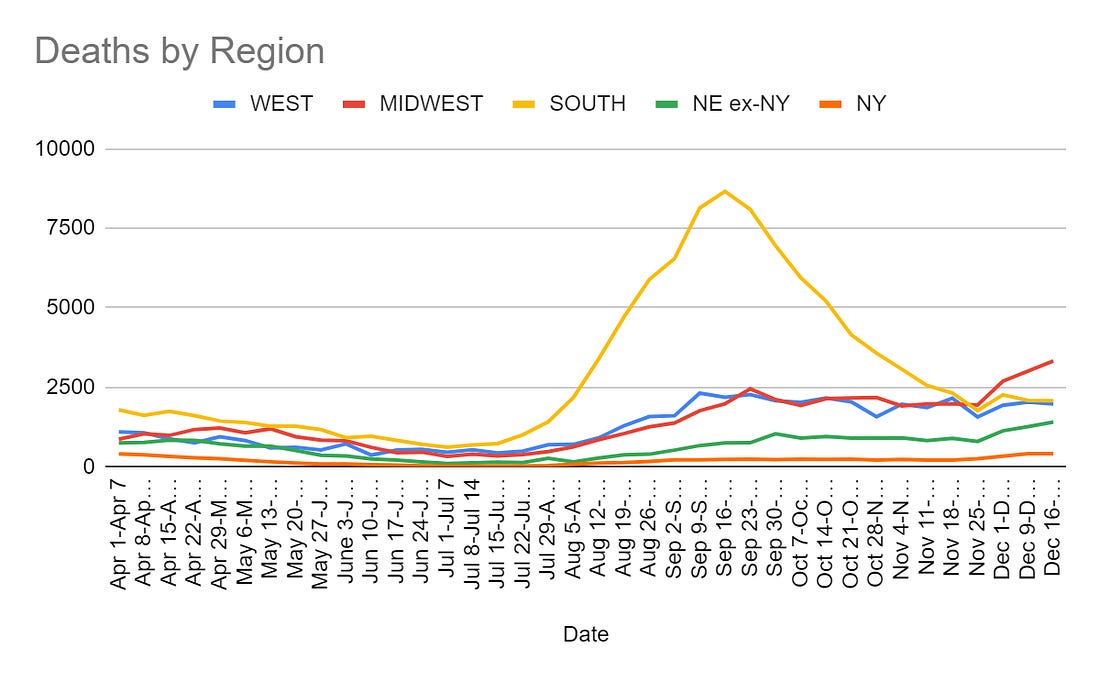

Deaths holding mostly steady most places including the UK:
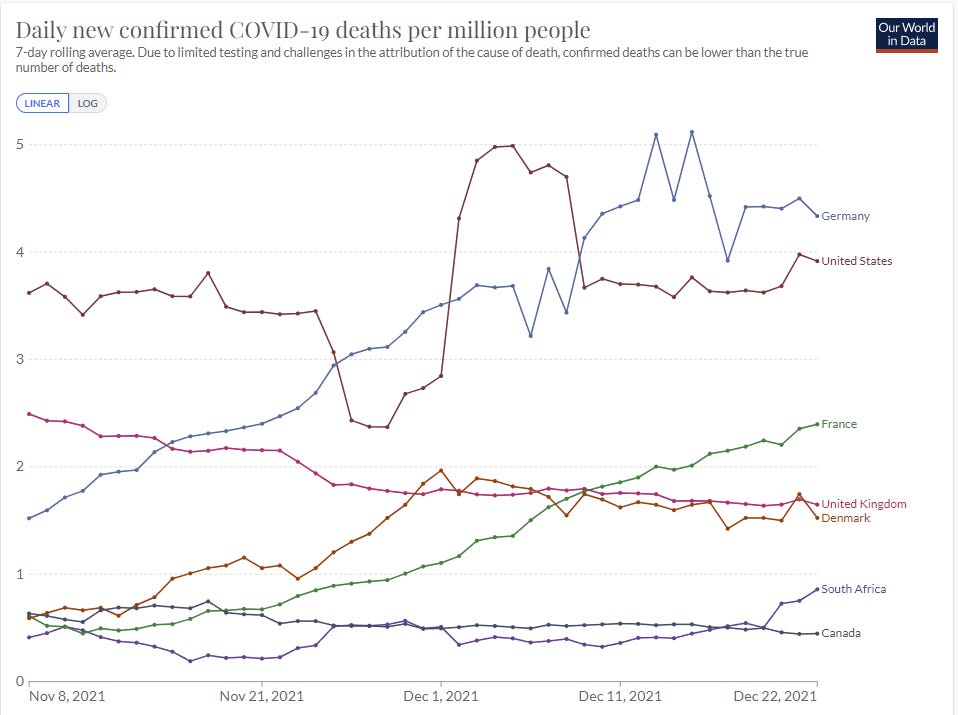
Cases
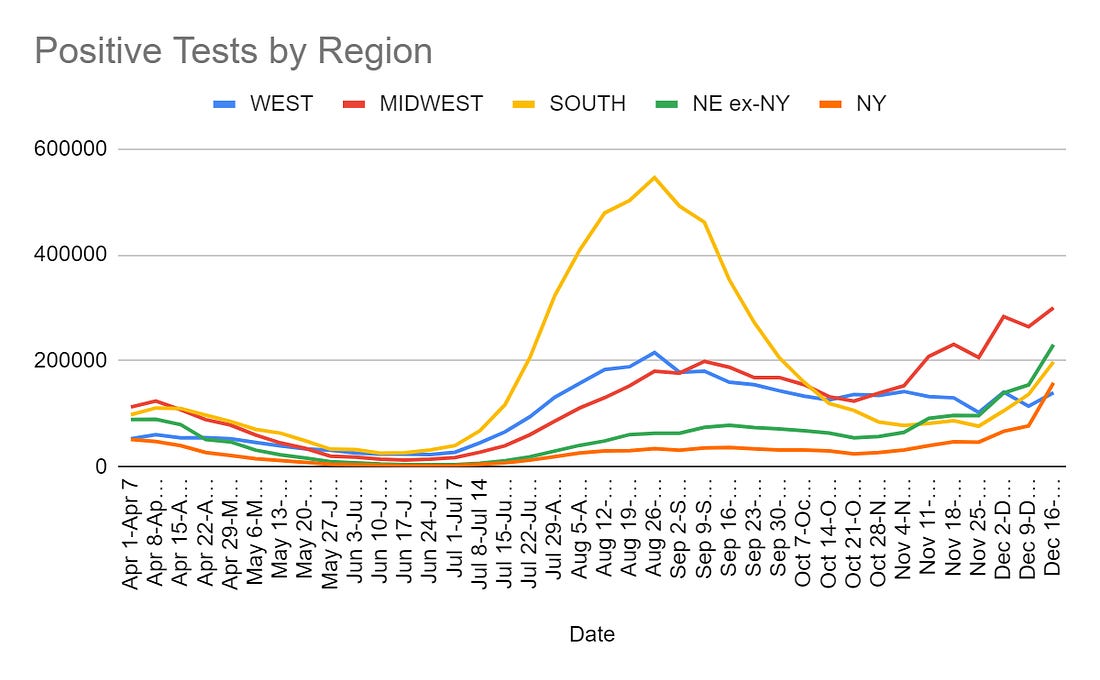

Periodically someone would ask why the Orange line for New York was still on the graph. Now we have more cases than the whole West, about 0.8% of our entire population in one week. That’s only the cases with reported positive tests, and this is probably only the beginning.
The other regions are behind, but they will catch up quickly.
For my international readers, a comparison chart.

That big final decline in Denmark isn’t real, as the website is recording a big zero for the final day, so ignore that.
Testing regimes are very different. For example, Germany’s death rate has been higher than the UK’s recently, even before Omicron, yet their case counts have been similar and are now lower. South Africa, assuming it peaked, almost certainly peaked with much higher actual case counts than indicated here.
Vaccinations
CDC recommends people not get J&J vaccine if mRNA vaccines are available. There was a bunch of worry that this would become fuel for vaccine skeptics ‘at the worst possible time’ (where the worst possible time is always right now), but that seems to not have happened.
My explanation for why that didn’t happen this time is simple. If mRNA vaccines are available, you shouldn’t get J&J, it doesn’t work as well especially against Omicron, so use the one that works better. Yes, the whole ‘condition that may lead to death’ thing is cited as a reason and is ludicrously overblown, but the ‘is less effective’ part is the part that counts and everyone knows that. What fuels vaccine hesitancy is when decisions are made that treat trivial worries like a big deal in order to not fuel vaccine hesitancy. When decisions are made that make sense, it’s fine.
Meanwhile, someone finally figured out that if the FDA committee is putting its own issues ahead of public health, you can just… not consult the committee. WaPo article here.
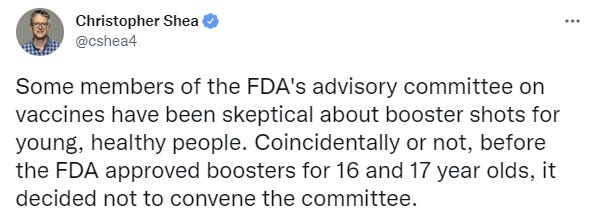
These sources are saying ‘oh no, this will hurt our credibility, you’re not following the procedure’ and I would say it’s not a moment too soon and we should learn from this example. The advisory committee is optional. It serves a valuable purpose when you need to understand the information in front of you, but that doesn’t mean you need to invite it to throw a fit for stupid reasons that provides you with no new insight and no new information. The first step to FDA Delenda Est.
Also, here’s a thread pointing out how not-close the math is on whether to vaccinate your kids, it even decreases myocarditis on net because it (get this!) prevents Covid-19 and Covid-19 is kind of bad for you with lots of side effects.
I only have one question about this cat. How do we know it was nine?

Vaccine Effectiveness
Yep, vaccines still work, an ongoing series, and remember the vaccinated population is older and was much more vulnerable before vaccination.
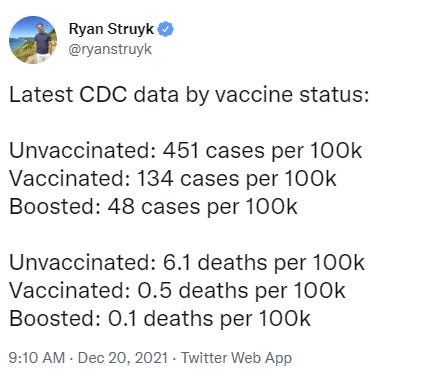
In other vaccine Not Necessarily the News, from the So It Has Come To This Department, they’re everywhere, so here’s a helpful PSA:

Hail hydra, bitch.
Vaccine Mandates
Yet another indication from Dr. Fauci that booster mandates are coming.
Biden has decided to turn up the rhetoric once more.

In addition to the winter of pain, it’s now an obligation to your country, and also your family and yourself. Them’s fightin words.
Fluvoxamine Remains Slightly Socially Awkward
There is also at least some risk that they’ll refuse to fill your prescription, but mostly the problem is that doctors aren’t prescribing it.
Why? Lack of knowledge, sure. But mainly mild social awkwardness, of course.
Scott Alexander explains the situation in an exceptional piece.
It has it all. You’ve got the scientific case for the drug, which seems very solid. You’ve got the FDA being so dysfunctional that they have no idea how to proceed with approving Fluvoxamine for Covid-19 because there’s no pharmaceutical company looking to profit off of it that can guide it through (although it looks like there might finally be a solution to this after many months, maybe). It’s got mild social awkwardness leading to lots of hospitalizations and deaths, called out for its central role, along with Scott going over how even he struggles with this and sometimes comes up short. You’ve even got a call to do the obviously correct thing.
On to the main event. Paxlovid!
Paxlovid No Longer Illegal
Today, the U.S. Food and Drug Administration issued an emergency use authorization (EUA) for Pfizer’s Paxlovid (nirmatrelvir tablets and ritonavir tablets, co-packaged for oral use) for the treatment of mild-to-moderate coronavirus disease (COVID-19) in adults and pediatric patients (12 years of age and older weighing at least 40 kilograms or about 88 pounds) with positive results of direct SARS-CoV-2 testing, and who are at high risk for progression to severe COVID-19, including hospitalization or death. Paxlovid is available by prescription only and should be initiated as soon as possible after diagnosis of COVID-19 and within five days of symptom onset.
Here’s the Stat News article on the approval. Here’s Some Weekend Reading’s coverage. Pills are on the way, if at first in limited quantities. It has begun. I also got a report on Twitter from the UK of someone who was potentially able to get it for their mum even before USA approval, so it’s already doing some good. It also seemed like the logistical arrangements were solid, which is an important potential point of failure.
Eric Topol calls upon us to use the Defense Production Act to speed up production of Paxlovid, now that it’s been approved (or at the time, clearly about to be approved) rather than addressing the problem that it only just got approved now, or suggesting the obvious first thing of putting in bigger orders and paying more money. The reason this isn’t ‘available to all’ are the barriers put in place and the lack of reliable willingness to pay.

Capitalism Solves This, all we have to do is pay. Pfizer even said they’d license to others, so this should (have been and should still) be a relatively easy one.
I myself made a few inquiries to people who might potentially be able to move the needle, but I came up empty. I didn’t push as hard or follow-up as much as I could have, and I’ve taken to asking myself why. My answer is that I didn’t have the felt experience that I could make a difference if I had some gumption and started playing to win the game. And I didn’t have that same sense of no, this is on you, someone has to and no one else will that I get at some other times, even though I knew damn well no one else would.
Instead, I was largely playing to just play, to say that I’d played at all. I was open to seeing a path forward, and tried a little to find one, but didn’t look that hard. Not good enough. Unacceptable. Better than nothing? Sure, absolutely, better than nothing, 99th percentile effort there. Did I have a lot of writing to do and a day job and a family and no first-order connections to anyone relevant? Yep.
But so what? All of that doesn’t count. Do, or do not. Either you shut up and do the impossible, and cut the enemy, or you don’t. Was this actually impossible from my position? I don’t know. But I also didn’t properly (f*** around and) find out. And this is my apology for that.
Now, a month later, it seems much more real to me that I might have been able to do something. So maybe, hopefully, next time, when something looks as tractable as this did, with as much on the line, I’ll use the try harder. And maybe some of you will use it too.
It is always a valid comment to ask me, so what are you going to do about it, punk? Even better is suggesting what it is I might do about it, but we have to start somewhere.
We have the doses we have. What are we going to do with them? We’re going to divide them among the states apportioned by population, and you can track that here. There doesn’t seem to be any adjustment for conditions in each state, and there definitely isn’t the ‘these states voted for me’ adjustment we saw from the previous administration. What will happen once those doses get delivered? Who gets them? We don’t know this. We only know the first stage.

A factor of three in a month is good, but not remotely enough. Proportionally to cases, it’s likely to be less not more.
In addition to the big good news, you know what else is legal? Remdesivir! And there’s a new study saying it’s 87% effective in reducing hospitalizations in high-risk patients via outpatient treatment.
Everything’s coming up treatments. Imagine if we acted like we cared.
This is The Way
It is all too rare how often the systems we have actually take care of people, and we can all use some good news, so I’m going to share this tale from NYC in full. This is The Way.


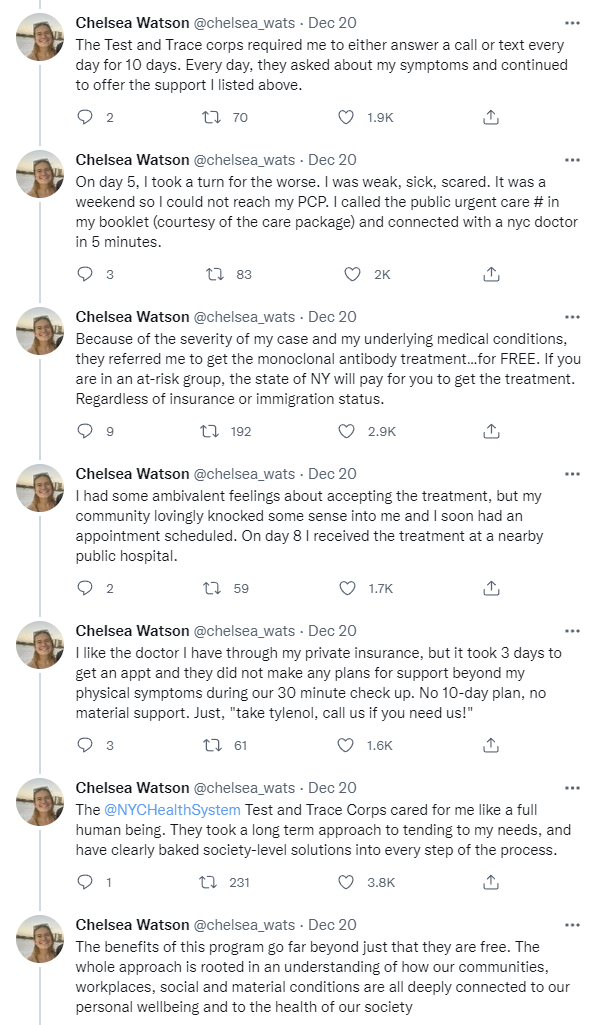

A program like this asks what would actually help solve the problems, for the sick individual’s health and social well-being too, to help them stay isolated and to help others realize they are infected. At least in Chelsea’s case, it focused on what mattered, and it got it done. Everybody wins. Yet we don’t talk about this almost at all, because authorities are terrified of what would happen if we focused on mitigation and helping those who are ill, instead of trying to force people to alter their behavior.
Flying Home for the Holidays
A lot of people have asked about traveling home for the holidays. It’s a little late to talk about it now, but I will reiterate that flying in an airplane is not a risky activity, and that this Bloomberg headline was almost certainly true (risk of everything is at least doubled, why would planes be different) but from a very low base rate, and it wasn’t based on anything beyond the logic above.
So this:

But also still this:

On most planes, the air exchange rate is approximately every three minutes and 75% comes from outside the plane, meaning that only 25% of cabin air is recirculated.
“The 767 and 777 both removed particulate 15 times faster than a home … and five to six times faster than recommended design specifications for modern hospital operating or patient isolation rooms,” the study continued.
What is risky is being at the airport. That’s an indoor interaction with a bunch of strangers potentially lasting hours, and that’s where your risk is when flying. Plan accordingly.

What is it about airplanes that demands ludicrous amounts of both actual safety (e.g. no plane crashes) and also security theater (e.g. the TSA), and now the masks? Is it purely that it’s profoundly unsettling to be flying through the air because that’s something humans aren’t supposed to be doing? Or is there more to it than that?
NPIs Including Mask and Testing Mandates
This seems right in terms of who restricts things when.
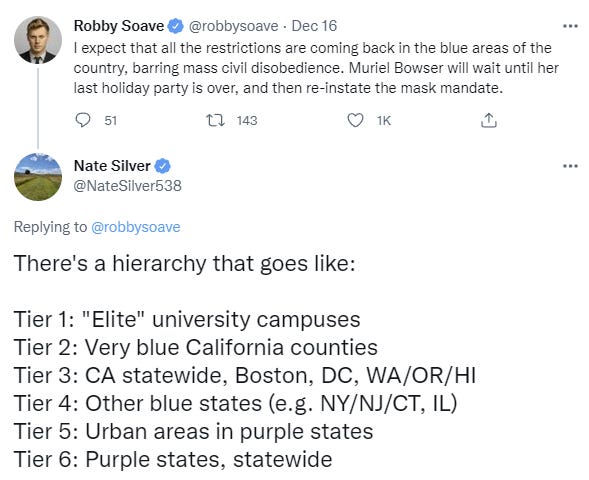
As noted below, Brown University isn’t taking steps, so even Tier 1 isn’t uniform. In general we’re not seeing much movement. Boston went to a vaccine mandate, but that’s about the only substantial move, and that’s a catch-up move. Washington, DC is following suit as announced yesterday, with one dose required on January 15 and two doses by February 15, in time for the Omicron wave to already be over. I don’t think this will ‘crush the hotel and restaurant industries’ or anything but it also won’t accomplish anything given the timeline.
The NYC Department of Corrections has halted all visits, and there’s a request to do the same for the state. I wonder if it’s the definition of chutzpah to say it’s too dangerous to allow visitors and yet keep all the prisoners locked up.
Sports Go Sports
Omicron is sweeping younger and more active populations first, and has a bigger advantage over Delta in more highly vaccinated groups, and more frequent testing of asymptomatic individuals will catch more Omicron cases.
Thus it is no surprise that professional sports are increasingly dealing with Covid outbreaks, and must figure out what to do. So far, the NHL is suspending its season, while the NBA and NFL (remember: no football, no peace!) are soldiering on.
The problem is that current quarantine rules and everyone getting Omicron don’t mix with playing a bunch of ballgames. This has been especially hard on the NBA, and that was five days ago.
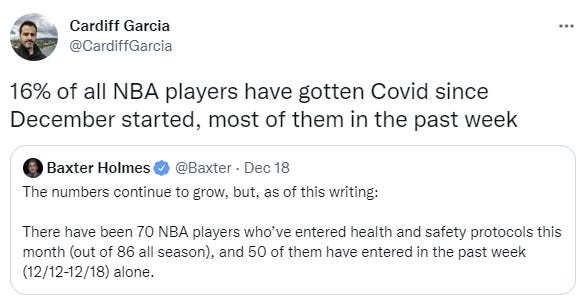
Here’s a post from a week ago detailing how bad things had already gotten, and what their dilemma was. The proposal here is quite aggressive.
The NBA actually has an opportunity here to end the precautionary moment, or at least signal its ebb. If commissioner Adam Silver steps forward and announces that his league is ending test protocols and treating this admittedly terrible disease in much the same way we deal with some other respiratory illnesses, that’s a potential cultural shift. The basic plan would be to test players and team officials only if they’re obviously sick (and sit said players if they test positive). And no more of the contact tracing that’s gummed up work behind the scenes of a highly mobile industry. The message could be simple: Look, we can’t functionally operate like it’s 2020; now that the disease is endemic, and vaccines are widely available, we must move into 2022.
That seems like too much. I wouldn’t have anyone quarantine based on contacts at this point, but if you have Covid-19, you shouldn’t be playing in NBA games until you’re negative. Otherwise the players don’t have time to properly recover, and could end up with long term health issues. If that means signing players off the street for a week, that’s what it means.
As someone who finds the NBA season too long and too monotonous, I kind of want to see teams scramble to deal with outbreaks. If you’re capable of winning the NBA title, you’re not going to be in any danger of missing the playoffs even if your team loses ten in a row while the stars are out, worst that can happen is another few away games, so why not spice things up a little?
Ministry of Truth
Twitter without Jack seems to increasingly have a censorship problem, with Covid-19 being a clear example. Which as always brings out less than the best in response, including people who misquote the policy to make it sound insane, so it’s important to notice exactly what’s happening. Here’s the policy.
The basic principles are thus:
What is in violation of this policy?
In order for content related to COVID-19 to considered violative under this policy, it must:
- advance a claim of fact, expressed in definitive terms;
- be demonstrably false or misleading, based on widely available, authoritative sources; and
- be likely to impact public safety or cause serious harm
In theory that should be fine. In practice ‘authoritative sources’ decide what is ‘demonstrably false or misleading’ based on what they think the public needs to hear rather than what the authorities believe is true, then changing their minds on what is to be considered true when they want the public to hear a different thing instead. Also the authorities are reliably behind in terms of figuring things out.
The requirement to ‘impact public safety or cause serious harm’ is not protective, because what information about Covid-19 doesn’t ‘impact public safety’ or ‘cause serious harm’ given the word ‘net’ is not included there?
Its examples of false claims, they include:
Claims that specific groups or people (or other demographically-identifiable identity) are more or less prone to be infected or to develop adverse symptoms on the basis of their membership in that group;
Older people are a demographically-identifiable group.
And also this:
Tweets that misrepresent or misuse official reporting tools/statistics.
I’m sure everyone who presented the CDC nowcast as fact is about to get suspended Real Soon Now. What does it mean to ‘misuse’ a statistic? Paging Mark Twain.
Finally, yes, here it is, but wait, it’s different and kind of weird:
False or misleading claims that people who have received the vaccine can spread or shed the vaccine (or symptoms, or immunity) to unvaccinated people.
Notice what this doesn’t say, or at least no longer says, which would be that vaccinated people can’t spread the virus. It instead says they can’t spread the vaccine or immunity to others, which they very much can’t, but is the kind of thing some anti-vax people worry about. Nor can they spread symptoms, because that’s not how symptoms work.
What they can spread is Covid-19, albeit less often than those who are unvaccinated. But the policy doesn’t say anything about that when you read it, at least in its current version. It says something else. The something else is so weird that I totally get how one could read it the wrong way, it’s almost a “Paris In The The Springtime” situation, but before hitting publish one needs to check and be sure.
In theory, any disagreement with public health authorities could count under the policy as written, since those same authorities decide what is ‘demonstrably false.’ In practice, I presume they’re not going to use it that way.
In theory the policy can lead to permanent account suspension. For that to happen, you have to mean it. A ban requires five strikes against your account. Mostly accounts will be effectively banned from talk about Covid-19 rather than fully permanently suspended.
Think of the Children
Stanford University was one of the first colleges to announce it was going remote.
Brown University is standing firm and not doing that (full statement).
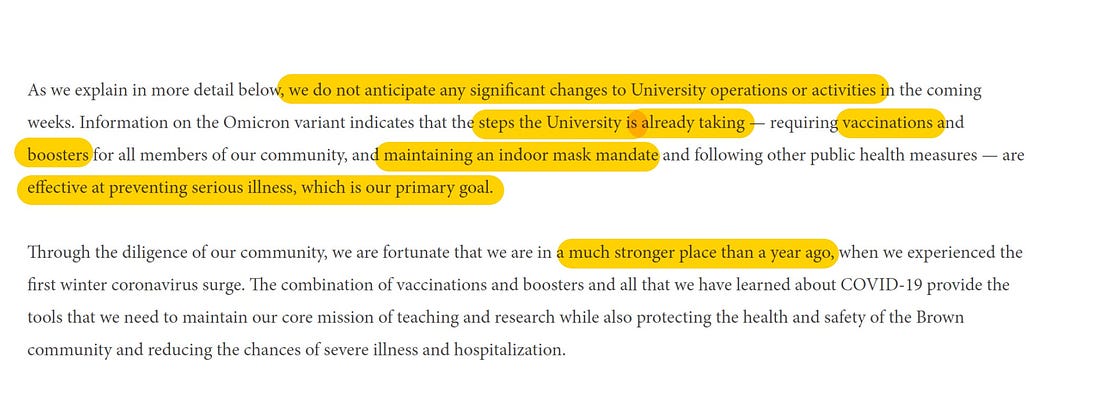
From The Atlantic and the You Should Know This Already department, The CDC’s Flawed Case for Wearing Masks in School.

Matthew Yglesias reminds us not to close the schools, given what in practice we do when we close the schools (as opposed to noticing school is terrible and fixing it) because it doesn’t accomplish much and does a lot of damage to kids.
The Cost of Prevention
Bryan Caplan asks how one measures an overreaction, calling the one to Covid the most expensive in history.
By my math, the total cost of the reaction for the U.S. was roughly fifteen times the total cost of the pandemic itself. (Similar calculations for Canada here). But that’s fifteen times a genuinely enormous cost of 800,000 lives, implying many trillions of dollars of overreaction.
In contrast: If the total cost of the reaction to shoe bombs was fifteen times the total cost of shoe bombs, the total harm would still be trivial, because shoe bombs themselves are trivial. You could have a 1000:1 ratio, and the sum of the harm of the overreaction would remain moderate. You might argue that a 1000:1 ratio is somehow more intellectually jarring. But if you could push a button to get rid of just one overreaction, you should clearly push the button that undoes more total harm, not the one with the most ludicrous cost/benefit ratio.
I agree with Bryan that what matters is the size of the overreaction, not its size relative to damage done. What I don’t agree with is that you can measure the reaction by comparing it to the damage done. You need to compare the cost of reaction to the damage prevented, in expectation, which is a different calculation.
Otherwise, you end up with ‘why did you spend so much making sure the bridge didn’t fall down, when it clearly didn’t fall down? What a waste of money!’ Or the at-most-slightly less dumb ‘Only two bridges fell down but we spent ten times that making sure other bridges didn’t fall down. What a waste of money.’
In the case of a pandemic and facing exponential growth, the counterfactual pandemic could easily be ‘most of us catch Covid in short order’ and it’s reasonable to compare that cost to the prevention cost. And you need to have model uncertainty of how bad this would get. As it turns out, that still says we paid too much in prevention costs, at least once we were out of the first few months, and definitely after vaccine availability.
Then again, it also means that when you spend over and over again preventing the same one-time harm, or you fight a battle you can’t win in the end, those costs add up, you’ve overpaid that much more. Don’t use your army to fight a losing battle.
Also, you should of course be comparing the costs and benefits of the reaction to a different reaction rather than to no reaction.
But it’s still a key rule of thumb to say that if you spent more preventing X than the cost of X, seems like you messed up.
Bryan also notes that the alternative regimes elsewhere overreacted more than us, which also seems right. That doesn’t let us off the hook, but relative to expectations and the actions of other countries is one hell of a grading curve.
Going forward, there’s value in blunting the gigantic spike that would otherwise be on top of us. But after that, the value goes way down, and it’s time for all of this to end.
In Other News
As a reminder, if you owe someone a great debt, you should pay them back.
A Lannister always pays his debts. America, not so much.
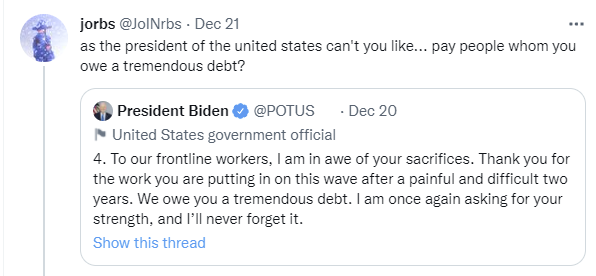
Here’s some examples of good communication about airborne transmission.
A neat little illustration of a transmission pattern.
Hospital capacity is under large strain already in many places, this is one example, and that’s before Omicron.
Bill Gates outlines his view of the situation, with four good things and one worry. The ‘worry’ is that people don’t trust untrustworthy governments, rather than those governments being untrustworthy. We’ve ‘learned a lot about how to deal with variants’ except that no we haven’t. We’ve ‘gotten really good at vaccines’ except we’re not moving that quickly to update them nor are we that good at getting people to get vaccinated (although obviously compared to last year, huge win and all that). We’re ‘developing better treatments’ but don’t seem that interested in scaling up and deploying them, and we’ve ‘learned a lot about mandates’ but it’s not clear to me what ‘we’ think we learned, or what that means for next time.
His later Twitter thread isn’t getting anything wrong, but also doesn’t offer useful insight. Seems like given his experience, knowledge and resources, he should be able to do better. I fear the world has taught him that he shouldn’t dare, and that this is as far as he is somehow ‘allowed’ to go.
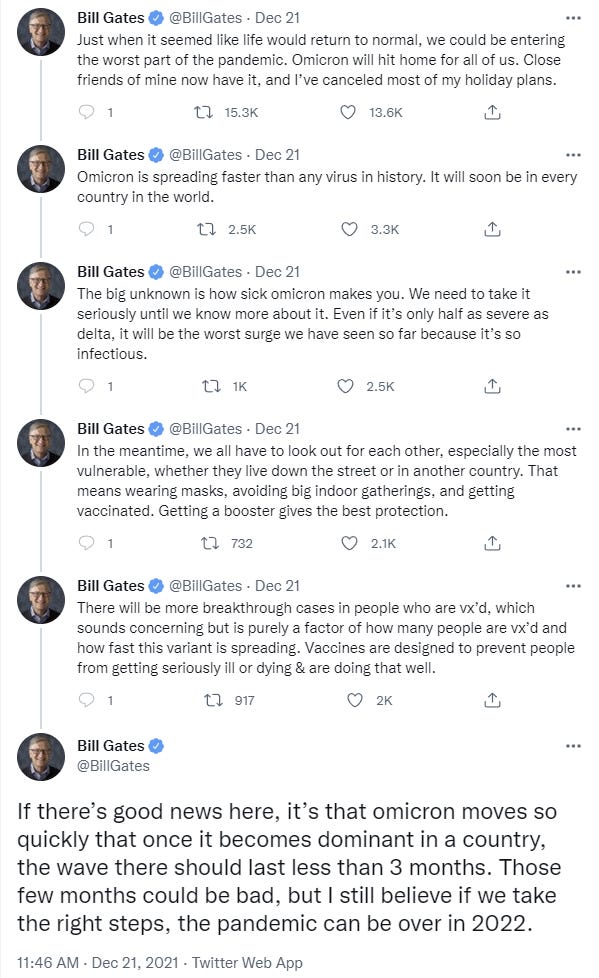

Not Covid
Robin Hanson once again points out that giving people better health care access doesn’t seem to give people better health outcomes? (Robin’s analysis post here, original paper here.)

Opportunity to purchase insurance led to 59.91% uptake and access to free insurance to 78.71% uptake. … Across a range of health measures, we estimate no significant impacts on health. … We conducted a baseline survey involving multiple members of each household 18 months before the intervention. We measured outcomes two times, at 18 months and at 3.5 years post intervention. … only 3 (0.46% of all estimated coefficients concerning health outcomes) were significant after multiple-testing adjustments. We cannot reject the hypothesis that the distribution of p-values from these estimates is consistent with no differences (P=0.31).
Here is Robin’s very reasonable conclusion, under the circumstances:
So a new randomized experiment on ordinary health residents of India had 6.8x as many subjects as the RAND experiment, and also found no net effect on health. It only looked at the effects of hospital treatment, but to many that is the crown jewel of medicine.
Bottom line: we now have more stronger data that on average, more medicine doesn’t improve health. Though of course for people committed to buying useless medicine insurance can cut financial stress. Update your beliefs accordingly.
Indian hospitals might be much less effective than American or European hospitals, but if there’s no effect that is still quite the thing to explain, and the sample sizes here are large. And we keep finding this same result.
OpenAI is giving their AI access to the internet in a known-to-be-exploitable-way during training. If you thought we were going to get killed by an AGI but at least maybe we would die with dignity, this is the exact opposite of dignity. I know many of my readers, especially new readers, aren’t that up on or invested in the question of AI Safety, but even a completely average person should be able to understand why rule number one is ‘for the love of God at a bare minimum you don’t give your AI access to the internet,’ seriously, what the hell. Could we at least pretend to try to take some precautions? It’s almost as if there are forces pushing towards OpenAI demonstrating that they couldn’t possibly care about safety. And I do appreciate the clarity. It helps one plan.
Article on superforecasting, and current chances of a Russian invasion of Ukraine according to the not-real-money prediction markets that aren’t afraid to go there.
Elon Musk offers a standard list of cognitive biases, so the next time you want to refer to them you can use him as a source, and hopefully all related stocks will go up.

Datapoints:
I texted both my PCP and a PA I’ve seen when the PCP was out of the country, asking if they perscribe fluvoxomine and budesinide. The PA replied back and said yes if you have risk factors (I do) and let me know that monocolodials are avaialbe with an easy-to-use online tool. The PCP texted back and said he has never done that and won’t be doing it. Friendship ended with PCP. PA is new best friend now. This is the same “weight loss expert” that didn’t know about wegovy. Neither did the PA, but she doesn’t see many overweight patients (in 2021?! How?).
My kids go to a charter school. This is not NY, but a blue state that is much, much less studied. Anyway, they are going mask-optional on return to class in January and have been Conspicuously Silent when I asked if they plan on revisiting that. They have had air filtrers running in every class room since bascially day 1. The school is run by a former Wall Street VP that got out of the rat race in their late 30’s. I continue to be marveled by this person. Sometimes, those who can, teach.
You asked for wegovy updates. Here’s one. I’ve been dealing with a major life stressor. The kind that involves FMLA and waiting around for diagnostic tests for a child. I’ve been eating ad libidum for a month. I gained ~2 lb. This is a miraculous result. I was expecting to have gained ~10. My wife has noticed that I’ve been eating a lot, particularly leaving more meals unfiinished. I didn’t notice. Also, my kid is going to be fine, now that we have figured out what is up and have access to the appropriate therapy.
Dear Zvi, two questions that are critically important for me now:
1. How likely am I to avoid the omicron infection under the following precautions? There are 4 people living in my apartment, in a block with 8 apartments and ~20 people. I will seal all the gravitational ventilation vents (grills) in my apartment with a couple layers of duct tape and paper/foil (in principle, the air goes from the apartments to the common duct and should not return, but there’s such a risk – I will keep the windows minimally opened all the time to further reduce this risk). There will be two air purifiers working 24/7. Nobody will leave the apartment over the course of the next 8-12 weeks, except for one person in an N95 mask and visor, going through the common staircase 3x a week (2*1 minute each time) to take the trash out. Any parcels will be received by the same person in an N95 mask and protective visor on the staircase (~20-second contact each time), and we will strive to minimize their number.
2. Given the current knowledge, how would you roughly update the Microcovid model – e.g. if weekly shopping had a 5,000 microcovid budget under delta, how would it likely look like now and in the upcoming weeks, given our knowledge on omicron’s prevalence, its basic reproduction number, resistance to the vaccines, etc?
Thank you so much in advance. I hope you’re feeling better.
1. I think that’s probably good enough, but you should likely upgrade the mask situation to P100 if you’re this serious. Relative to your other precautions it’s cheap. More Dakka.
2. Assume that you’re much closer to population-average, and look at the current level of Covid and what you think they’re doing? My guess is Omicron wipes out a lot of your immunity, plus it also spreads faster on top of that, and has a smaller generation time, overall maybe multiply risk by 3 with same number of cases but also cases are currently at least one doubling behind reality, effectively 2 or more in some places, etc.
“Claims that specific groups or people (or other demographically-identifiable identity) are more or less prone to be infected or to develop adverse symptoms on the basis of their membership in that group;”
That claim is remarkably false on almost every dimension. Obviously old people are more likely to be infected, but also men have about 1.5x the CFR of women, blacks about 2x the CFR of whites and Hispanics about 2x the case rate (but the same CFR) [all of these numbers are pre-vaccination /delta so may have changed].
The extreme lack of curiosity about all of this is emblematic of our societal failures.
Why do blacks have 2x the CFR of whites?
Systemic racism!
How does systemic racism actually cause this
Systemic racism!
I was actually interested in Bryan Caplan’s “by my math” calculation, and I could totally believe that something like 15X was true, but if you read his post, there’s no math there at all. He just asks:
“Suppose you could either live a year of life in the COVID era, or X months under normal conditions. What’s the value of X?”
And then asserts that the answer is 10 (and has a twitter poll to support this). Note that even under a perfect government response that living under COVID would be less pleasant than the before times, so even as stated this isn’t measuring the government reaction.
A more realistic question might be to say you have the chance to move to a similar country with a better COVID response, but if you accept that there’s a X% chance that you get shot and killed instead. What value of X would you accept to be indifferent to moving? I bet that almost everyone would have an X VERY close to zero. (and that’s by my math!…)
I’m asking this here because I suddenly have need of the information, have very little time to search for it, and figure Zvi or someone else here probably has ballpark-figures already:
1. What proportion of U.S. (GA specifically, if possible) covid cases were omicron on Dec 18th?
2. How effective are two-shot and two-plus-one-booster vaccine regimens vs. delta and vs. omicron? I gather the omicron figures are still an educated guess, but I’ll take what I can get.
3. Any numbers on false negative/positive rates for PCR or rapid tests may also be helpful.
(context: I host the local family Christmas party. My brother just reported his potential exposure, and I’m trying to calculate the odds that he caught either variant from their base rates plus his and his contact’s vaccination statuses. Everyone at the party is vaccinated, but I personally am immunocompromised, so a risk calculation seems worth it before I decide whether postpone and/or tell him to stay home)
1. Without thinking too hard or looking locally, 30%? 40%? But depending on definitions that could be off by a lot (e.g. infected on 18th? Tested on 18th? Symptoms?). Higher in Atlanta, lower in the countryside.
If your context is *what percentage of infections you detect on the 24th* will be Omicron? 80%.
2. Everyone’s guessing but something like 50% and 80% for 2-shot and 3-shot maybe.
3. Read Michael Mina for stats, but basically PCRs are right about whether you have it but too slow to be useful, rapid tests tell you whether you’re infectious and are like 90% to identify with few false positives.
Believed infected the 18th. The specific sequence of events is as follows: Person A attended a party on the 18th, fell ill on the 19th, and was diagnosed with covid (variant unspecified) the 21st. Person B attended the same party on the 18th, and was presumably exposed to either A or whoever infected A. My brother was exposed to person B for most of the 21st.
Neither B nor my brother have symptoms. B has had a PCR test, but as you say, it may not have a result soon enough to be useful. My brother is looking for a rapid test but has not found one yet.
My underlying assumption is that, iff B was infected and contagious on the 21st, they were likely infected at the party on the 18th, either by A or a common source; therefore, the base rates on the 18th are what matter. Knowing the base rates, A’s vaccination status, and the vaccine’s relative effectiveness vs. different strains, I can calculate the probability that the strain involved is omicron. Knowing that, plus the vaccination statuses of B and my brother, I can calculate the probabilities of each strain passing through both of them. (probability relative to baseline transmission, I mean; I am not sure what the baseline transmission chance is, I think the microcovid project has numbers for that part though)
(this doesn’t account for uncertainty about the infection source, but there’s only so much I can do with the information I have)
My gut estimate is that with two vaccinated people in the chain, the risk is basically nil for delta but possibly-relevant for omicron.
If it happened that fast, on top of everything else, it’s Omicron.
Sorry, could you unpack that for me? If you’re referring to A’s known infection, I don’t know for sure that its progression was that fast — A is the presumptive source and could have been infected before the party.
If you mean “any infection B might have from that exposure, if it began on the 18th and was contagious on the 21st, would have to be omicron”, that sounds plausible. I don’t recall the delta/omicron incubation periods off the top of my head, but if delta incubation is >3 days then yes, that screens off Delta from the relevant cases — that is, if A’s case is Delta then I don’t need to care, because it couldn’t possibly have jumped to B and then my brother.
(some back of the envelope math suggests that I’m actually at less risk if A is completely unvaccinated, because it makes Delta more likely. I find that vaguely hilarious)
Is the belief that (1 dose of J&J) is worse than (2 doses of MRNA) or is the belief that (n doses of J&J) is worse than (n doses of MRNA) for some n?
I can easily see us deciding to deprecate J&J when the first of these is true but not the second. Since we approved single doses of J&J, we must treat it as a single dose forever, obviously.
Zvi, I trust that neither you nor your family is too ill if you’re sustaining such a high frequency of posts. Hoping to soon hear you’ve recovered; fingers crossed.
Your posts are usually pretty clear, but this time I don’t understand your apology. Which needle do you think was more movable than you expected? Paxlovid supply? And why are you writing in such a wistful tone, as if the chance is gone? If it “seems more real” now, then surely this is the perfect time to try it, now that you have optimism on your side?
Getting things started for real in November seems like it was a much bigger opportunity – I was thinking I could get more capacity online faster, by seeking out those who had the ability and convincing them to do it, and arranging for them to make money, and all that. At this point, by the time we could possibly spin up a new factory line somewhere else, the wave will be over, and the urgency will be gone.
Ah, so it’s all about doing it before it’s becomes urgent, rather than after it doesn’t matter as much. Thanks, that makes sense.
It would be interesting to know how far you would take this belief?
(1) For example, I believe markets often mis-price things, e.g., not taking into account externalities or product life cycle costs (pollution, waste, health impacts on workers, etc.).
The price of oil in particular and fossil fuels in general don’t price in climate change, pumping money into the volatile Middle East, and so on. Pharmaceuticals are often mis-priced in the US because we stupidly made it illegal for Medicare to negotiate drug prices.
Other markets, like say Treasury bonds, have all the information available to everybody, and make pretty decent decisions so there’s little to arbitrage. That seems a fine place to let price be our guide. It’s important to me to know which kind of market is setting the price, and how much I trust it.
(2) Also, while there are actuarial prices on human lives used to quantify the utility of safety regulations, I wouldn’t say that murdering a person should be acceptable in exchange for sufficient money paid to their estate. (Though there have been legal systems in the past where that was the case.)
Having said that, markets setting prices feels a bit to me like getting a utility function exactly right. If you can do that, utility is a fine guide to action; sometimes markets are transparent enough that we can price them correctly, like Treasury bonds.
But, at least insofar as I observe the world, we often do not do that.
So in some cases, like the value of a life, I prefer to be far more cautious. It’s kind of like epistemic humility: if I’m not sure I understand the price being set, then I get really cautious.
What I meant by that statement is something like:
1. Some thing T is bad, and will cause (you estimate) expected disutility of about X.
2. You can try and prevent/mitigate T, and avoid cost X, by paying Y.
3. If Y>X, you f***ed up.
I’m confused what this has to do with market prices, probably a misunderstanding. But in the case of the prices on human lives, isn’t that exactly the point? This life is worth $X (e.g. 10 million dollars) so make sure your intervention to save them is worthwhile.
That doesn’t mean I can turn around and murder them in exchange for $X (or $2X), because of reasons we mostly agree on and need not go into. That would end badly. But it does mean that it isn’t reasonable to force me to incur $2X in economic losses per life saved, in e.g. a lockdown. All makes sense to me – you do have to draw the line somewhere, so let’s pick a number.
Zvi, you shouldn’t wring yourself for not being the Comet King.
Have a Christmas rich in warm fuzzies!
I finally read through the paxlovid documents and wrote up some thoughts.
The final figures on efficacy are 87.8% (CL: 75.1% – 94.0%).
They stratified patients by various interesting variables (gender, age, BMI, diabetes, …) and found it was still effective in all the subgroups.
Also, a quick note on the fact that molnupiravir got an EUA today, much to my surprise.
Micro-fiction that jingles in my mind:
Bill Gates finally decided to take matters into his own hands. Through a lab he funds in South Africa with immunized mice, here it is, just in time: a variant spreading like wildfire, as mild as possible, giving everybody immunisation and a chance to say “Now I’m over it.” His own Christmas present to the world. Merry Christmas everyone!
Does anyone know of a NYC-area doctor that is willing to prescribe Fluvoxamine (Luvox)? I started having symptoms this weekend, but two rapids taken on subsequent days came back negative. I took another one last night and that was positive. My doctor at Mt. Sinai said they are seeing, with Omicron, the tests don’t come back as positive until you have a lot of viral load so more false negatives early in the course of illness.
He also said they could not offer me any treatment — Mt. Sinai won’t give you Sotrovimab, even with “risk factors,” unless you are unvaccinated, because they consider breakthrough infections to be low risk, and he had never heard of Fluvoxamine. When I pointed him to the Johns Hopkins guidelines and the Scott Alexander post on Fluvoxamine, he quickly skimmed it and said it was unpersuasive because no proven reduction in mortality — and he thinks there are risks of SSRIs such as suicidal ideation. Hence, trying to see if I can do a quick consult today with someone who might be more up on the studies (he was clearly just reacting quickly on the call; he didn’t have a good answer why he wouldn’t do it given the Johns Hopkins recommendation).
https://nitter.kavin.rocks/michaelzlin/status/1473818094573441030#m is the worst thing I’ve heard related to covid in over a year! tl;dr FDA is considering approving molnupiravir which is likely to increase the rate of harmful new strains
The possible creation of new variants was discussed at the AMDAC committee meeting. Indeed, that was one of the reasons the vote to recommend was split 13-10. The other reasons included mutagenicity in pregnancy, and the weirdly lower efficacy in the 2nd half of the clinical trial.
My guess is that the danger of creating a new variant is low, so long as people take the full course of treatment. That will induce so many viral mutations that the virus falls apart and simply cannot replicate (which is the idea). You’d have to very foolishly take only a little bit of the prescribed meds to raise the danger of a variant. (Of course, if a lot of people take it, someone may eventually be a knucklehead who does just that.)
Nonetheless, as of yesterday, molnupiravir has an official emergency use authorization. There are a bunch of limits placed on it, such as the recommendation that it only be used where better alternatives (like paxlovid) are “unavailable or clinically inappropriate”.
So: cat, bag, meow!
> a useful treatment option for some patients with COVID-19 at high risk of hospitalization or death,
https://www.statnews.com/2021/12/23/fda-authorizes-mercks-covid-19-pill-but-stresses-its-use-should-be-limited/
This suggests to me that people will be self-administering this drug at home. People don’t take the full course of antibiotics even when directed to, even when their infection mutates and becomes treatment resistant. So I expect the likelihood of this drug creating new variants is high, because people won’t take the full course of treatment.
I think the Kerala study deserves a more thorough read than Robin gave it. I don’t think it proves no health benefits, nor even is that the most likely outcome.
The paragraph immediately following Robin’s quote undermines his read:
> Care should be taken in interpreting the insignificant health effects observed. Perhaps the effect of hospital care on measured outcomes is too small to translate into health improvements that we have power to detect despite our substantial sample size (Das, Hammer et al. 2008)…. medically significant effects for many outcomes cannot be ruled out… Finally, given the low premiums for RSBY insurance, it would require a rather precise nearly zero estimate of health effects to rule out that government spending on freely provided insurance was not cost-effective.
What size effect can they detect? Actually only large ones in the context:
> Our target sample size, 2,250 households per group, ensured 80% power to detect a 25% change in hospitalization rate across groups at the 5% significance level, allowing for 10% attrition and assuming a hospitalization rate in the control group of 10.5% and 11.8% in Mysore and Gulbarga (National Sample Survey Organisation 2004), respectively. We doubled the sample size for the free-insurance group to increase power for the most likely form for any future insurance expansion.
I don’t know the literature – but a 25% reduction (approx 2.5-3pp) in hospitalization seems high as a target? Maybe not unreasonable as a best case, but certainly seems high as a floor. I’d want to do a full cost/benefit but I suspect a 5-10% reduction in hospitalizations would be great news at the price we are talking about here and this study was not powerful enough to resolve that size of effect.
Also, note their analysis was at the household level, so I think you need to consider N=2250, not the larger number of participants that you and Robin seem to be considering the sample size. This analysis is less statistically powerful than the RAND study he refers to.
Anyway, as you quoted Robin’s quote here, how are you interpreting this?
> We cannot reject the hypothesis that the distribution of p-values from these estimates is consistent with no differences (P=0.31)
(With lower epistemic certainty, as I am not a statistician) I believe this means they put a 31% chance of no-effect, which is surprisingly high to me, but not proof of no-effect. Are you reading this differently? When Robin says “ found no net effect on health”, isn’t this overstating the case? No-effect was not conclusively found. Nor was an effect. I think people reading this summary and not the paper would take away a very different conclusion than from reading the paper directly.
What do we need to explain here? Is it just that it’s as high as 30% for something that many take for granted? I’m reading more certainty (particularly from Robin but also from you) that this paper proves “no-effect” instead of just inconclusive results. Is it just that you think this is a weak enough result that it should update us away from the commonly-held belief that insurance is good?
One other concern i have is regarding all the tests they run, diluting their power on a couple high-impact ones. They tracked something like 60 endpoints, most of which seem irrelevant or overly-specific for an N=~2000 study. (“Was out of breath in the last 4 weeks”). I’d rather look at only mortality or only hospital admissions and narrow those confidence intervals. I’m not a statistician so I don’t have the expertise to critique this quantitatively, but it seems suspect. I think this undermines “only 0.47% of endpoints had stat sig” as a source of concern. If you’d tracked 1000 endpoints you would have zero at stat sig after correcting.
it’s worth noting that the main takeaways the authors summarize is that this study shows that in India, most recipients of a new insurance program were not able to actually use it to obtain treatment, either by not knowing how it works, being rejected at providers, forgetting the card, etc, which has questionable transferability to developed countries with existing high-quality health services.
Several million people had received a booster five months ago (mainly in Turkey and the Emirates), so we should be starting seeing whether the immunity from a booster decays any slower than that from the primary vaccination cycle. Have we?